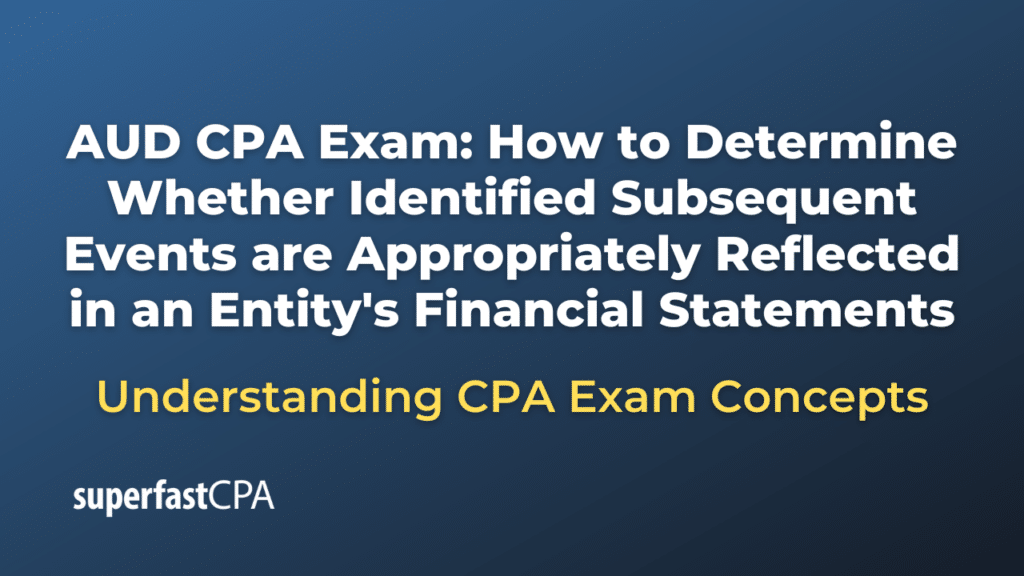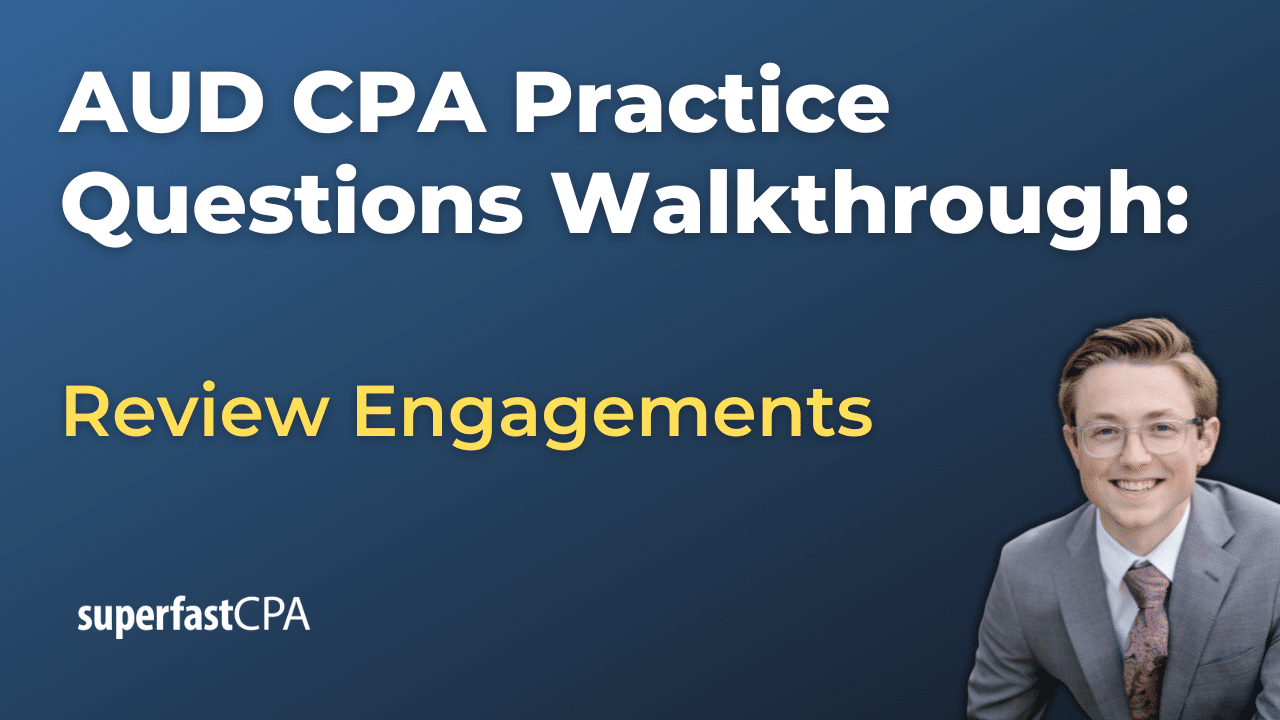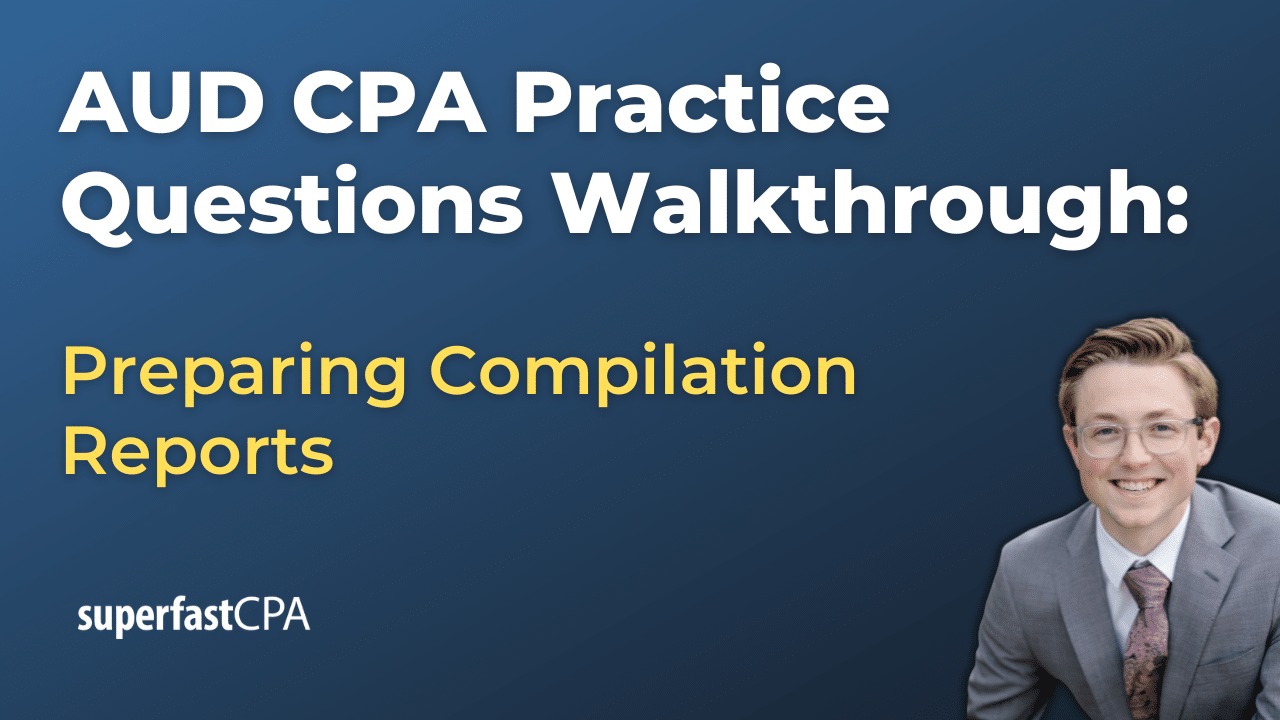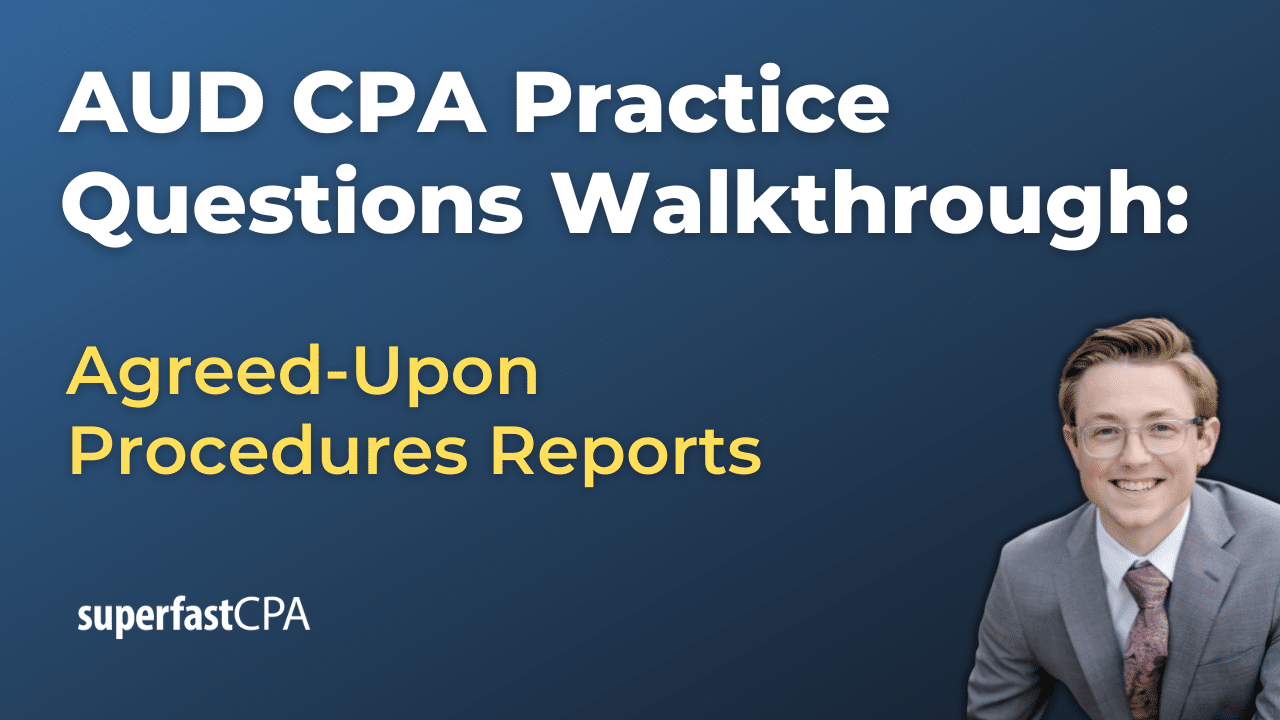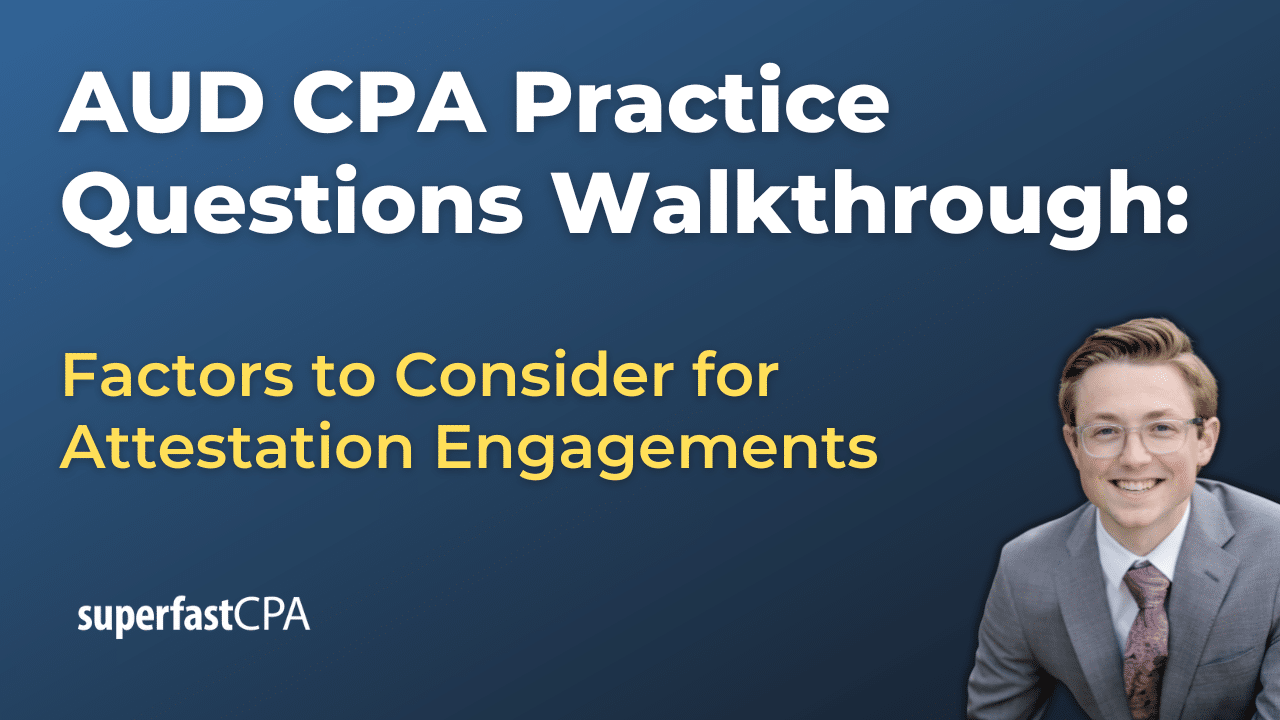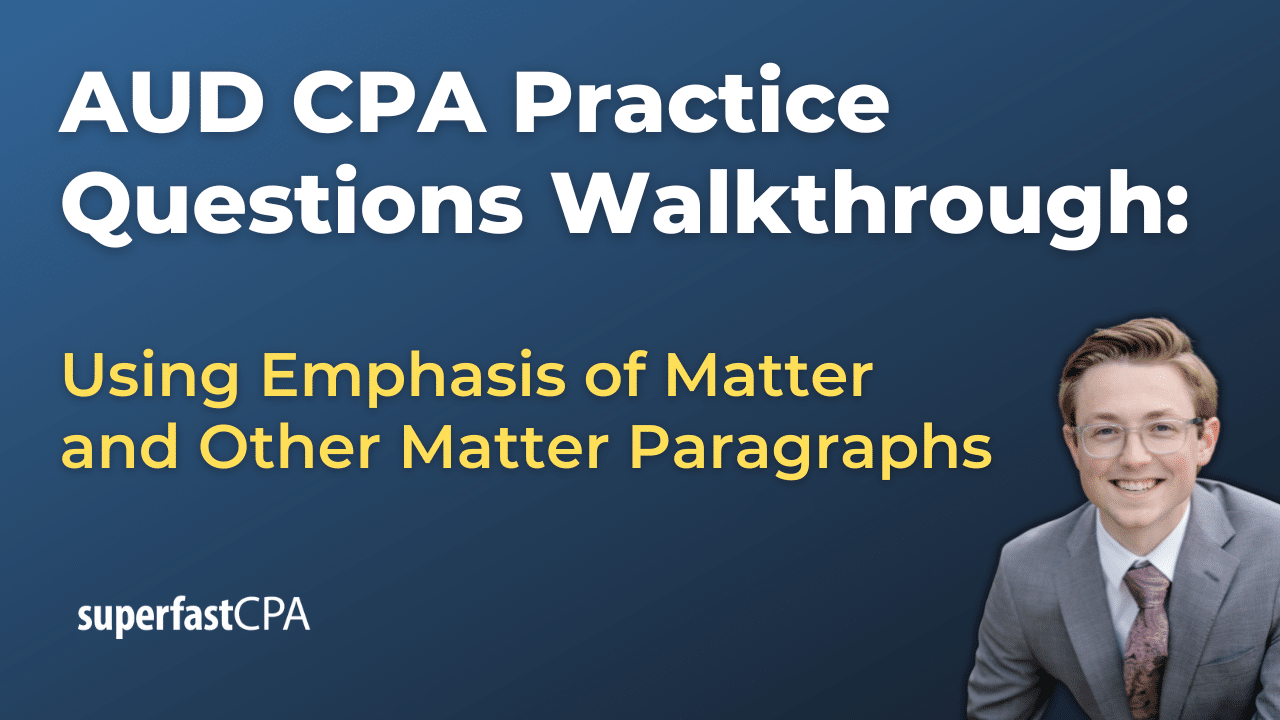Introduction
Purpose of the Article
In this article, we’ll cover how to determine whether identified subsequent events are appropriately reflected in an entity’s financial statements. The primary purpose of this article is to provide an in-depth understanding of subsequent events and their significance in the preparation and auditing of financial statements. Subsequent events are critical because they can impact an entity’s financial position, performance, and the accuracy of its financial statements. These events occur after the balance sheet date but before the financial statements are issued, and determining how they should be reflected in the financial statements is essential for accurate reporting.
For auditors, understanding subsequent events is crucial in ensuring that the financial statements are free from material misstatements. Failing to properly account for subsequent events can lead to incorrect financial information being presented to stakeholders, which can have significant legal and financial implications for both the entity and the auditor. This article will guide you through the identification, evaluation, and reflection of subsequent events in financial statements, providing the knowledge necessary to assess whether they have been appropriately addressed in an entity’s financial reporting.
Overview of Subsequent Events
Subsequent events are occurrences that happen after the balance sheet date but before the financial statements are issued or available to be issued. These events can have a significant impact on the financial statements and must be carefully considered to determine whether they require adjustments to the financial statements or simply disclosure.
There are two primary types of subsequent events:
- Type 1 (Recognized Subsequent Events): These events provide additional evidence about conditions that existed at the date of the balance sheet. For instance, the settlement of a lawsuit after the balance sheet date may provide evidence of a liability that should have been recognized in the financial statements. Adjustments to the financial statements are usually required for Type 1 events to reflect the accurate financial position and results as of the balance sheet date.
- Type 2 (Non-Recognized Subsequent Events): These events provide evidence of conditions that arose after the balance sheet date. An example could be the destruction of a major asset due to a natural disaster occurring after the balance sheet date. While these events do not result in adjustments to the financial statements, they may require disclosure to prevent the financial statements from being misleading.
The significance of subsequent events lies in their potential to alter the perceived financial health and operational outcomes of an entity. Properly identifying and reflecting these events ensures that stakeholders have a complete and accurate understanding of the entity’s financial situation as of the balance sheet date, thereby maintaining the integrity of financial reporting.
Understanding Subsequent Events
Definition and Types of Subsequent Events
Subsequent events refer to occurrences that take place after the balance sheet date but before the financial statements are issued or are available to be issued. These events are crucial in financial reporting as they can affect the financial position, performance, and cash flows of an entity, necessitating careful consideration by both management and auditors.
Subsequent events are broadly classified into two categories:
Type 1 (Recognized Subsequent Events)
Type 1 subsequent events are those that provide additional evidence about conditions that existed at the date of the balance sheet. These events offer insight into circumstances that were present as of the balance sheet date but were not fully recognized or evaluated in the financial statements.
Examples of Type 1 Events:
- Settlement of Litigation: If an entity was involved in litigation as of the balance sheet date and the case is settled after the date but before the financial statements are issued, the settlement provides evidence of the liability that existed as of the balance sheet date. The financial statements may need to be adjusted to reflect the settlement amount.
- Bankruptcy of a Major Customer: If a significant customer declares bankruptcy after the balance sheet date, and it can be shown that the financial difficulties existed before the balance sheet date, an adjustment may be required to the allowance for doubtful accounts.
Adjustments to the financial statements are generally necessary for Type 1 events to ensure that the financial position and results of operations as of the balance sheet date are accurately reflected. These adjustments help in presenting a true and fair view of the financial condition of the entity.
Type 2 (Non-Recognized Subsequent Events)
Type 2 subsequent events are those that provide evidence about conditions that arose after the balance sheet date. These events are significant for the financial statements, but they do not require adjustments to the figures reported as of the balance sheet date. Instead, they may require disclosure to prevent the financial statements from being misleading.
Examples of Type 2 Events:
- Natural Disasters: If a company’s major production facility is destroyed by a natural disaster after the balance sheet date, this event did not exist at the balance sheet date, so no adjustment is made to the financial statements. However, it may be necessary to disclose the event in the notes to the financial statements to inform users of the significant impact on the entity’s future operations.
- Issuance of Debt or Equity: The issuance of debt or equity instruments after the balance sheet date is an example of a Type 2 event that would not affect the balance sheet as of the date, but it is important information for financial statement users.
Disclosures for Type 2 events help ensure that stakeholders are aware of significant developments that could affect the entity’s future financial condition or operations, even though these developments did not exist as of the balance sheet date.
Importance of Identifying Subsequent Events
Identifying subsequent events is vital because they have the potential to impact the accuracy and completeness of an entity’s financial statements. Properly recognizing and disclosing these events ensures that the financial statements present a true and fair view of the entity’s financial position and results of operations.
For Type 1 events, failure to adjust the financial statements can lead to misstated figures that do not reflect the actual conditions as of the balance sheet date. This could mislead stakeholders and result in decisions based on inaccurate information.
For Type 2 events, inadequate disclosure can result in stakeholders being uninformed about significant risks or opportunities that arose after the balance sheet date. This lack of information can lead to misinformed decisions and could damage the entity’s reputation or financial standing if stakeholders believe important information was withheld.
The thorough identification and appropriate reflection of subsequent events in the financial statements are crucial for maintaining the integrity of financial reporting. They ensure that all relevant information is considered and communicated, thus supporting the decision-making processes of stakeholders.
Identifying Subsequent Events
Sources of Information
Identifying subsequent events requires a thorough review of various sources of information within and outside the entity. Auditors and management need to consider a wide range of documents and communications to ensure that all relevant events have been captured and properly evaluated. Below are some key sources of information that can help in identifying subsequent events:
Review of Internal and External Communications
Internal and external communications provide valuable insights into events that could impact the financial statements. These communications include:
- Internal Memos and Emails: Internal communications between management and staff can reveal events or decisions made after the balance sheet date that might affect the financial statements. For example, a memo discussing potential asset impairments due to changes in market conditions could be a sign of a subsequent event.
- Correspondence with Legal Counsel: Communications with legal counsel can provide critical information about ongoing or settled litigation, regulatory actions, or other legal matters that could be subsequent events. Such correspondence can help identify whether there have been settlements or new developments in legal cases after the balance sheet date.
- External Communications with Customers and Suppliers: Letters or emails from customers or suppliers may indicate significant changes, such as the bankruptcy of a key customer or the termination of a major contract, that need to be considered as subsequent events.
Analysis of Minutes from Board Meetings
Board meeting minutes are an essential source of information for identifying subsequent events. These minutes often capture strategic decisions and discussions about significant events that occur after the balance sheet date. Auditors and management should carefully review the minutes for:
- Approval of Major Transactions: If the board approves the acquisition or sale of significant assets after the balance sheet date, this could be a subsequent event that requires disclosure or adjustment in the financial statements.
- Discussions on Financial Difficulties: Any discussion related to financial difficulties, such as cash flow issues or concerns about a major customer’s solvency, could point to a subsequent event that needs to be reflected in the financial statements.
Post-Balance Sheet Period Transactions
Transactions that occur after the balance sheet date but before the financial statements are issued can provide direct evidence of subsequent events. These transactions include:
- Receivables and Payables: Reviewing transactions related to receivables and payables can indicate whether customers or suppliers are experiencing difficulties, which may require an adjustment to the allowance for doubtful accounts or disclosure of potential risks.
- Inventory Sales: Post-balance sheet inventory sales at significantly different prices than recorded in the financial statements could suggest the need for an adjustment to the valuation of inventory as of the balance sheet date.
- Capital Expenditures: Significant capital expenditures after the balance sheet date could be an indicator of changes in business strategy or financial condition, which may require disclosure.
Examples of Subsequent Events
To better understand the types of subsequent events that might arise, here are some common examples and how they could impact financial reporting:
Settlement of Litigation
If an entity is involved in litigation as of the balance sheet date and the case is settled after the date but before the financial statements are issued, the settlement is considered a Type 1 subsequent event. This means it provides evidence of the liability that existed at the balance sheet date, and the financial statements may need to be adjusted to reflect the settlement amount accurately.
Bankruptcy of a Major Customer
The bankruptcy of a major customer after the balance sheet date but before the issuance of financial statements is another example of a subsequent event. If the financial difficulties leading to bankruptcy existed as of the balance sheet date, this is a Type 1 event, and adjustments to the financial statements may be required, such as revising the allowance for doubtful accounts. If the bankruptcy arose from events after the balance sheet date, it may be a Type 2 event, necessitating disclosure without adjustment.
Sale or Acquisition of a Significant Asset
The sale or acquisition of a significant asset after the balance sheet date is typically considered a Type 2 subsequent event. While this does not require an adjustment to the financial statements as of the balance sheet date, it is a significant event that may affect the entity’s future operations and financial condition. Therefore, it should be disclosed in the notes to the financial statements to inform stakeholders of the event’s potential impact.
These examples illustrate the variety of subsequent events that can occur and the importance of identifying them through careful review of available information. Properly recognizing and reflecting these events ensures that financial statements are complete, accurate, and provide a true representation of the entity’s financial position and performance.
Evaluating the Impact of Subsequent Events
Assessing Type 1 Events
Type 1 subsequent events are those that provide additional evidence about conditions that existed at the balance sheet date. These events often require adjustments to the financial statements to ensure that they accurately reflect the entity’s financial position as of that date. Assessing these events involves determining whether the financial statements should be adjusted and, if so, how these adjustments should be made.
How to Determine if These Events Should Be Adjusted in the Financial Statements
When assessing Type 1 subsequent events, the key consideration is whether the event provides evidence about a condition that existed at the balance sheet date. If it does, an adjustment is generally required to ensure the financial statements reflect the true state of affairs as of that date.
Steps to Determine Adjustment Needs:
- Identify the Condition: Determine whether the condition related to the subsequent event existed as of the balance sheet date. This involves reviewing the nature of the event and its connection to the financial period under audit.
- Evaluate the Evidence: Assess the additional evidence provided by the subsequent event. This could include new information that was not available at the balance sheet date but sheds light on the conditions that existed then.
- Consider Materiality: Determine the materiality of the event. If the event is material and affects the financial statements’ accuracy or completeness, an adjustment is necessary.
- Adjust the Financial Statements: If the event is deemed to impact the conditions at the balance sheet date, adjust the relevant accounts in the financial statements. This might involve revising asset valuations, recognizing liabilities, or updating disclosures.
Examples of Adjustments
Revisions to Asset Valuations:
- Impairment of Assets: If a subsequent event reveals that an asset was impaired as of the balance sheet date (e.g., a major customer went bankrupt, affecting the collectability of receivables), the asset’s carrying amount should be adjusted to reflect its recoverable amount. This ensures that the asset is not overstated in the financial statements.
- Inventory Valuation: Suppose an event occurring after the balance sheet date reveals that inventory was overvalued due to obsolescence or damage that existed but was not identified until after the year-end. In that case, the inventory should be written down to its net realizable value as of the balance sheet date.
Recognition of Liabilities:
- Litigation Settlements: If a subsequent event involves the settlement of litigation that was pending at the balance sheet date, and the settlement amount is higher than what was initially estimated, the liability should be adjusted to reflect the actual settlement amount. This adjustment ensures that the financial statements accurately present the entity’s obligations as of the balance sheet date.
- Warranty Claims: If additional warranty claims are made after the balance sheet date but relate to products sold before that date, the entity may need to adjust the warranty liability to reflect the higher-than-expected claims, ensuring the financial statements are not understated.
Adjusting the financial statements for Type 1 subsequent events ensures that they present a true and fair view of the entity’s financial position and results of operations as of the balance sheet date. This process is essential for maintaining the integrity and reliability of financial reporting.
Assessing Type 2 Events
Type 2 subsequent events are those that provide evidence about conditions that arose after the balance sheet date. While these events do not typically require adjustments to the financial statements, they may necessitate disclosure to ensure that stakeholders are fully informed about significant developments that could impact the entity’s future operations and financial condition.
How to Determine if Disclosure is Required Without Adjustment
When assessing Type 2 subsequent events, the primary consideration is whether the event is significant enough to warrant disclosure in the financial statements. Disclosure is necessary when the event is likely to influence the decisions of users of the financial statements, even though it does not alter the financial position as of the balance sheet date.
Steps to Determine Disclosure Needs:
- Identify the Nature of the Event: Evaluate the event to determine whether it is related to new conditions or developments that occurred after the balance sheet date.
- Assess Materiality: Consider the materiality of the event. If the event is significant and could affect users’ understanding of the entity’s future prospects, it likely requires disclosure.
- Evaluate the Impact: Consider how the event impacts the entity’s operations, financial condition, or strategic direction. Events that have a substantial impact on these areas are more likely to require disclosure.
- Decide on the Form of Disclosure: Determine the appropriate level of detail for the disclosure. The disclosure should provide enough information to give users a clear understanding of the nature and potential impact of the event.
Examples of Disclosures
New Business Ventures:
- Launching a New Product Line: If a company initiates a new product line or enters a new market after the balance sheet date, this could be a significant event that warrants disclosure. Although it does not require adjustment to the financial statements, disclosing this event provides stakeholders with important information about the company’s future growth potential and strategic direction.
- Formation of a Joint Venture: Entering into a joint venture with another company after the balance sheet date can have significant implications for the entity’s future operations. Disclosing this event helps users understand the potential impact on future revenue streams, expenses, and overall business strategy.
Significant Capital Investments:
- Acquisition of a Major Asset: If the entity acquires a significant asset, such as a new manufacturing facility, after the balance sheet date, this event should be disclosed. The acquisition may represent a major shift in the entity’s operational capabilities or geographical footprint, and stakeholders should be made aware of this development to accurately assess the entity’s future financial performance.
- Large Capital Expenditure: A substantial investment in new technology or infrastructure after the balance sheet date may require disclosure. This investment could affect the entity’s future profitability, efficiency, or competitive position, and disclosing it provides users with critical information about the entity’s long-term strategy and financial outlook.
Disclosing Type 2 subsequent events ensures that the financial statements provide a complete and transparent view of significant developments that, while not altering the financial position as of the balance sheet date, are important for understanding the entity’s future prospects. This practice is essential for maintaining the credibility and reliability of financial reporting.
Reflecting Subsequent Events in Financial Statements
Criteria for Recognition and Disclosure
Properly reflecting subsequent events in financial statements is essential to ensure that the financial information presented is accurate and complete. The criteria for recognizing or disclosing subsequent events depend on the type of event and its impact on the financial statements.
When to Adjust Financial Statements for Type 1 Events
Type 1 subsequent events provide additional evidence about conditions that existed at the balance sheet date. Adjustments to the financial statements are required when these events reveal new information that affects the entity’s financial position as of the balance sheet date.
Criteria for Adjustment:
- Condition Existed at Balance Sheet Date: The event must relate to a condition that was present as of the balance sheet date, even if the full extent of the condition was not known at that time.
- Material Impact: The event must have a material impact on the financial statements. If the event significantly affects the valuation of assets, liabilities, or equity, an adjustment is necessary to present an accurate financial position.
- Examples:
- A legal settlement that provides new information about a liability that existed as of the balance sheet date.
- A customer’s bankruptcy that indicates an account receivable should have been impaired.
Adjustments for Type 1 events should be made in the financial statements to reflect the true financial position as of the balance sheet date, ensuring that the financial statements are not misleading.
When to Disclose Type 2 Events Without Adjustments
Type 2 subsequent events relate to conditions that arose after the balance sheet date. These events typically do not require adjustments to the financial statements because they do not affect the financial position as of the balance sheet date. However, disclosure is necessary if the event is material and could influence the decisions of users of the financial statements.
Criteria for Disclosure:
- New Condition Arising After Balance Sheet Date: The event must pertain to conditions or circumstances that developed after the balance sheet date.
- Material Impact on Future Operations: The event must be significant enough to affect the entity’s future financial condition, operations, or strategic direction. If the event could influence the economic decisions of users, it should be disclosed.
- Examples:
- A significant acquisition or sale of assets that occurred after the balance sheet date.
- The issuance of new debt or equity that could impact the entity’s future capital structure.
Disclosures for Type 2 events should provide sufficient detail to inform users of the nature of the event and its potential implications, without altering the figures presented in the financial statements.
Documentation and Evidence
Proper documentation and evidence are critical for supporting the decisions made regarding the recognition or disclosure of subsequent events. This documentation ensures that the rationale for these decisions is clear and can be audited or reviewed if necessary.
How to Document the Rationale for Recognizing or Disclosing Subsequent Events
When determining whether to recognize or disclose a subsequent event, it is important to thoroughly document the decision-making process. This documentation should include:
- Description of the Event: Provide a detailed description of the subsequent event, including the date it occurred and how it was identified.
- Assessment of Impact: Document the assessment of the event’s impact on the financial statements. This should include an analysis of whether the event relates to conditions existing at the balance sheet date (Type 1) or arose afterward (Type 2).
- Decision Rationale: Clearly state the rationale for either adjusting the financial statements or disclosing the event. This rationale should be based on the criteria discussed above and should reference relevant accounting standards or guidelines.
- Approval and Review: Include evidence of management’s approval of the decision and any reviews conducted by auditors or other relevant parties.
Best Practices for Maintaining Audit Trails and Evidence
Maintaining a robust audit trail and supporting evidence for decisions related to subsequent events is essential for ensuring transparency and accountability. Best practices include:
- Centralized Documentation: Keep all documentation related to subsequent events in a centralized location that is easily accessible for audit or review purposes.
- Consistent Processes: Establish and follow consistent processes for identifying, assessing, and documenting subsequent events. This consistency helps ensure that all relevant events are captured and treated appropriately.
- Evidence Retention: Retain all evidence that supports the recognition or disclosure decisions, including emails, meeting minutes, legal correspondence, and financial analysis. This evidence should be retained in accordance with the entity’s document retention policy.
- Regular Reviews: Conduct regular reviews of subsequent events documentation to ensure compliance with accounting standards and internal policies. These reviews can be part of the entity’s internal controls over financial reporting.
By adhering to these best practices, entities can ensure that subsequent events are appropriately reflected in their financial statements, and that the decisions made regarding these events are well-documented and supported by evidence. This not only enhances the accuracy of financial reporting but also strengthens the credibility of the financial statements in the eyes of stakeholders.
Auditor’s Responsibilities
Review Procedures
Auditors have a critical responsibility in identifying and evaluating subsequent events to ensure that the financial statements present a true and fair view of an entity’s financial position. To fulfill this responsibility, auditors must follow specific review procedures designed to uncover any subsequent events that might require adjustment or disclosure.
Standard Procedures for Identifying and Evaluating Subsequent Events During an Audit
Auditors should implement a series of standard procedures to identify and evaluate subsequent events effectively. These procedures typically include:
- Review of Post-Balance Sheet Transactions: Auditors should examine transactions that occurred after the balance sheet date but before the issuance of the financial statements. This review can reveal events that need to be recognized or disclosed in the financial statements.
- Analysis of Minutes from Board Meetings: Reviewing the minutes of board meetings held after the balance sheet date can provide insights into significant decisions or discussions that may constitute subsequent events.
- Examination of Interim Financial Statements: Comparing interim financial statements prepared after the balance sheet date to the audited financial statements can help identify events that may require further investigation or disclosure.
- Review of Legal and Regulatory Filings: Auditors should review any legal or regulatory filings made after the balance sheet date to determine if they contain information about subsequent events that could impact the financial statements.
Inquiries and Correspondence with Management and Legal Counsel
Communication with management and legal counsel is a vital component of the auditor’s review procedures. These inquiries help the auditor gather information about potential subsequent events that might not be readily apparent from the entity’s records.
- Inquiries with Management: Auditors should directly inquire with management about any events or conditions that may have arisen after the balance sheet date. Specific questions might include:
- Has there been any significant change in the entity’s financial position since the balance sheet date?
- Have any new legal matters or settlements occurred?
- Are there any new business developments, such as acquisitions or disposals, that should be disclosed?
- Correspondence with Legal Counsel: Auditors should also review correspondence with the entity’s legal counsel to identify any new or ongoing legal matters that could represent subsequent events. This review might involve:
- Obtaining legal letters from the entity’s counsel to confirm the status of any litigation, claims, or assessments as of the date of the financial statements.
- Inquiring about the outcome of any legal matters that were pending as of the balance sheet date.
These inquiries and correspondences help ensure that all relevant subsequent events are identified and properly evaluated for their impact on the financial statements.
Implications for the Auditor’s Report
Subsequent events can have significant implications for the auditor’s report. Depending on the nature and impact of these events, the auditor may need to modify their opinion or include additional disclosures in the auditor’s report.
How Subsequent Events Can Affect the Auditor’s Opinion
If a subsequent event is identified and it materially affects the financial statements, the auditor must consider how this event impacts their opinion. The impact on the opinion will depend on whether the event is a Type 1 or Type 2 subsequent event and whether the financial statements have been appropriately adjusted or disclosed.
- Unmodified Opinion: If the subsequent event has been correctly identified and reflected in the financial statements, whether through adjustment or disclosure, the auditor can issue an unmodified opinion. This opinion indicates that the financial statements are presented fairly, in all material respects.
- Modified Opinion: If the auditor determines that the subsequent event has not been adequately addressed in the financial statements—either because necessary adjustments were not made for a Type 1 event, or because a Type 2 event was not disclosed—the auditor may need to issue a modified opinion. This could take the form of a qualified opinion, an adverse opinion, or a disclaimer of opinion, depending on the severity of the misstatement or omission.
Considerations for Issuing a Modified Report
When considering whether to issue a modified report, the auditor must evaluate the significance of the subsequent event and the adequacy of the entity’s response. The auditor should consider the following:
- Materiality: The materiality of the subsequent event is a key factor in determining whether a modified opinion is necessary. If the event is material and the financial statements have not been appropriately adjusted or disclosed, a modification to the opinion may be required.
- Nature of the Event: The auditor should assess whether the event is likely to mislead users of the financial statements if not properly addressed. For example, if a significant liability has not been recognized, or if a major post-balance sheet acquisition has not been disclosed, the financial statements may present an inaccurate picture of the entity’s financial condition.
- Management’s Response: The auditor should consider whether management has provided a sufficient explanation or corrective action in response to the auditor’s concerns. If management refuses to make necessary adjustments or disclosures, the auditor may need to issue a modified report to alert users of the financial statements to the potential misstatement or omission.
In some cases, the auditor may also include an “Emphasis of Matter” paragraph in the auditor’s report to highlight a significant subsequent event that has been appropriately disclosed but warrants additional attention by users of the financial statements.
By following these procedures and carefully evaluating the impact of subsequent events, auditors can ensure that their reports accurately reflect the financial statements’ fairness and reliability, thereby upholding the integrity of financial reporting.
Case Studies and Practical Examples
Real-World Scenarios
Understanding the application of subsequent event principles is greatly enhanced by examining real-world scenarios. These case studies illustrate how entities have identified and reflected subsequent events in their financial statements, highlighting the decision-making process for recognition versus disclosure.
Case Studies Illustrating the Identification and Reflection of Subsequent Events
Case Study 1: Litigation Settlement After Balance Sheet Date
Scenario: A manufacturing company was involved in a lawsuit as of the balance sheet date, with a potential liability estimated by management. After the balance sheet date but before the financial statements were issued, the company settled the lawsuit for an amount significantly higher than the estimate.
Identification and Reflection: This is a Type 1 subsequent event, as it provides additional evidence about conditions that existed at the balance sheet date. The company’s legal counsel confirmed that the circumstances leading to the lawsuit were present as of the balance sheet date. Consequently, the company adjusted its financial statements to reflect the actual settlement amount. The auditor reviewed the settlement agreement and management’s adjustment, concluding that the financial statements were appropriately revised.
Case Study 2: Acquisition of a Significant Asset Post-Balance Sheet Date
Scenario: A retail company acquired a new distribution center after the balance sheet date to expand its operations. The acquisition was finalized before the issuance of the financial statements.
Identification and Reflection: This event is a Type 2 subsequent event because it pertains to conditions that arose after the balance sheet date. The acquisition does not impact the financial position as of the balance sheet date, so no adjustments to the financial statements were necessary. However, due to the material nature of the acquisition, the company disclosed the event in the notes to the financial statements. The auditor reviewed the purchase agreement and confirmed that disclosure, rather than adjustment, was the appropriate treatment.
Practical Examples Showing the Decision-Making Process for Recognition vs. Disclosure
Example 1: Bankruptcy of a Major Customer
Scenario: A company’s major customer declared bankruptcy after the balance sheet date but before the financial statements were issued. The customer’s financial difficulties were ongoing as of the balance sheet date, and the company had a significant accounts receivable balance from this customer.
Decision-Making Process:
- Step 1: The company evaluated whether the customer’s financial difficulties existed as of the balance sheet date. Given that the difficulties were ongoing, the event was classified as a Type 1 subsequent event.
- Step 2: The company assessed the impact on the financial statements, determining that the accounts receivable balance from the customer should be written off.
- Step 3: The financial statements were adjusted to reflect the impairment of the receivable, ensuring the financial position was accurately represented as of the balance sheet date. The auditor confirmed that the adjustment was appropriate and adequately supported by evidence.
Example 2: New Regulations Affecting Operations
Scenario: New environmental regulations were announced after the balance sheet date, which will significantly increase the operating costs of a manufacturing company in the coming year.
Decision-Making Process:
- Step 1: The company determined that the new regulations did not exist as of the balance sheet date, classifying this as a Type 2 subsequent event.
- Step 2: Since the regulations will materially affect the company’s future operations, management decided that disclosure was necessary to inform stakeholders about the potential impact.
- Step 3: The company included a detailed note in the financial statements explaining the nature of the new regulations and their expected impact on future operating costs. The auditor reviewed the disclosure and agreed that no adjustments to the financial statements were needed, but that the disclosure provided valuable information to users.
These case studies and examples demonstrate the importance of carefully assessing subsequent events and making informed decisions about whether to recognize them in the financial statements or disclose them in the notes. Properly handling these events ensures that the financial statements provide a true and fair view of the entity’s financial position and performance, both as of the balance sheet date and in light of significant post-balance sheet developments.
Common Pitfalls and How to Avoid Them
In the process of identifying and reflecting subsequent events in financial statements, there are common pitfalls that entities and auditors can encounter. Misinterpretation of subsequent events and failure to properly disclose significant events can lead to material misstatements or incomplete financial disclosures. Understanding these pitfalls and how to avoid them is crucial for maintaining the integrity of financial reporting.
Misinterpretation of Subsequent Events
One of the most common pitfalls is the misinterpretation of whether a subsequent event is a Type 1 (recognized) or Type 2 (non-recognized) event. This misinterpretation can result in either inappropriate adjustments to the financial statements or failure to recognize necessary adjustments.
Example of Misinterpretation:
- Scenario: A company learns after the balance sheet date that a customer is facing financial difficulties and may not be able to pay its outstanding balance. The customer’s financial issues began before the balance sheet date but were not fully understood at that time.
- Pitfall: The company misinterprets this as a Type 2 event and decides not to adjust the accounts receivable balance, thinking that the financial difficulties only became significant after the balance sheet date.
- Impact: This misinterpretation results in the financial statements being overstated because the accounts receivable should have been written down as a Type 1 event.
How to Avoid:
- Thorough Analysis: Always perform a thorough analysis of the timing and nature of the event. Determine whether the conditions leading to the event existed as of the balance sheet date.
- Consultation: Engage with legal counsel, management, and other relevant experts to fully understand the circumstances surrounding the event.
- Documentation: Document the rationale for classifying the event as Type 1 or Type 2, supported by evidence and professional judgment.
Failure to Properly Disclose Significant Subsequent Events
Another significant pitfall is the failure to properly disclose Type 2 subsequent events. Even if an event does not require adjustment to the financial statements, it may still be material enough to warrant disclosure. Failure to do so can leave stakeholders uninformed about critical developments that could impact their decision-making.
Example of Failure to Disclose:
- Scenario: After the balance sheet date, a company enters into negotiations to acquire a competitor. The acquisition is finalized before the financial statements are issued, but the company decides not to disclose the event, thinking that it will not affect the current period’s financial position.
- Pitfall: The lack of disclosure means stakeholders are unaware of a major strategic shift that could significantly impact the company’s future performance.
- Impact: This omission could lead to stakeholder decisions based on incomplete information, potentially damaging the company’s credibility and leading to regulatory scrutiny.
How to Avoid:
- Materiality Assessment: Carefully assess the materiality of all subsequent events, considering both the financial and strategic impact on the entity.
- Proactive Disclosure: When in doubt, err on the side of disclosure. Even if an event does not affect the financial figures, it may still be important for users to know about it.
- Clear Communication: Ensure that the disclosure is clear, concise, and provides all necessary information to help stakeholders understand the potential impact of the event on the entity’s future operations.
By being aware of these common pitfalls and taking proactive steps to avoid them, entities and auditors can ensure that subsequent events are correctly identified, classified, and reflected in the financial statements. This not only enhances the accuracy and completeness of financial reporting but also strengthens trust and transparency with stakeholders.
Conclusion
Summary of Key Points
Reflecting subsequent events appropriately in financial statements is a crucial aspect of accurate and reliable financial reporting. Subsequent events can have a significant impact on an entity’s financial position, performance, and cash flows, and therefore must be carefully evaluated to determine whether they require adjustments or disclosures.
Key points to remember include:
- Understanding the Types of Subsequent Events: Recognize the difference between Type 1 events, which require adjustments to the financial statements, and Type 2 events, which typically necessitate disclosure without adjustments.
- Evaluating the Impact: Properly assess whether a subsequent event affects the financial position as of the balance sheet date (Type 1) or represents a new condition that arose afterward (Type 2).
- Reflecting Events in Financial Statements: Ensure that Type 1 events are accurately reflected through adjustments, and that significant Type 2 events are disclosed in the notes to the financial statements to provide a complete picture to stakeholders.
- Avoiding Common Pitfalls: Be vigilant in avoiding common errors such as misinterpreting the nature of subsequent events or failing to disclose significant events that could influence stakeholder decisions.
Final Thoughts
The process of identifying, evaluating, and reflecting subsequent events in financial statements requires diligence, thoroughness, and sound professional judgment. Auditors and financial statement preparers must maintain a high level of scrutiny to ensure that all relevant events are appropriately addressed. This not only ensures compliance with accounting standards but also reinforces the integrity of the financial statements.
Accurate financial reporting depends on a comprehensive understanding of subsequent events and their potential impact. By adhering to best practices and avoiding common pitfalls, entities can provide stakeholders with reliable financial information that accurately reflects their financial position and future prospects.
In conclusion, diligence in the assessment of subsequent events is not just a regulatory requirement—it’s a critical component of maintaining trust and transparency in financial reporting.

